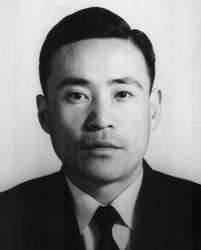Suh Chong Kang
| Suh Chong Kang | |
 Kang Suh Chong | |
| Hangul | 강서종 |
|---|---|
| Revised Romanization | Gang Seojong |
| McCune–Reischauer | Kang Sŏjong |
Kang Suh Chong started his martial arts training in 1938 in Yudo, Su Bahk Do, and later became a student of Tang Soo Do/Kong Soo Do under Lee Won Kuk (Chung Do Kwan Founder) and is a graduate of the first class of Chung Do Kwan Black Belts. In 1953 he founded his own branch of Tae Kwon Do and named it Kuk Mu Kwan. From 1957 to 1969 Kang served as the head instructor of the Korean Central Intelligence Agency (KCIA), formerly known as Korean Military Intelligence Agency, and from 1960 to 1968 he was the commanding instructor for the Republic of Korea (ROK) Army.
Kang came to the United States in 1969, already an 8th Dan Black Belt, with his family and founded his own Tae Kwon Do academy in Brooklyn, New York. Physically he was known for his power, breaking techniques, and superior knowledge of the Chang Hon Forms. He became the first President of the American Tae Kwon Do Association (ATA) from 1969 to 1978.[1] However his name is not mentioned in the history of the ATA. Even though Haeng Ung Lee (ATA Co-Founder) was a student of Kang. This is due to the political take over of the ATA by H.U. Lee in 1978.
He served as the Vice President of the International Tae Kwon Do Federation in the late 1970s. He is currently the Chairman of the All American Tae Kwon Do Federation, which is based in Brooklyn, New York.

Before his death, Chung Do Kwan founder Lee Won Kuk promoted Kang Suh Chong to the rank of 10th Dan Black Belt. He was the first one of the original Chung Do Kwan Black Belts to receive this honor. Today, Kang Suh Chong's Tae Kwon Do System continues to grow through the teachings of his three sons, who are also Grand Masters and have their own Tae Kwon Do schools and organizations. On April 10, 2009 Kang Suh Chong was inducted into the official Taekwondo Hall of Fame.[2]